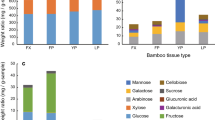Abstract
The possibility of feeding on green and newly fallen leaves of the small-leaved lime Tilia cordata was studied for the collembolans Protaphorura armata and Vertagopus pseudocinereus. Young leaves grown under sterile conditions and almost free of yeast fungi were found to be toxic to the collembolan V. pseudocinereus: feeding on them led to the death of the animals. Leaves grown under natural conditions were nontoxic: when used by the collembolans as feed, they provided for collembolan growth and fecundity. Feeding preferences of the collembolans in relation to the yeasts attributed to different ecomorphs—epiphytes, litter saprophytes, pedobionts, and saccharobionts—were studied. Of the 24 yeast strains isolated from plant green parts, litter, and soil and assigned to eight species, no strain was revealed that was not used by the collembolans. However, certain yeast strains were preferable for the collembolans. The population of the V. pseudocinereus collembolans feeding on the yeast Rhodotorula glutinis (nss 31–4) exceeded that grown on Cryptococcus terricola (2044) 1.5-fold. Thus, the collembolans have feeding preferences in relation to yeast fungi, as was shown earlier with mycelial micromycetes. The possible mechanisms of the feeding preferences of the collembolans in relation to yeasts are discussed.
Similar content being viewed by others
References
Mindermann, G. and Daniels, L., Colonization of Newly Fallen Leaves by Microorganisms, Progress in Soil Biology, Braunschweig, 1967, pp. 3–9.
Booth, R.C. and Anderson, J.M., The Influence of Fungal Food Quality on the Growth and Fecundity of Folsomia candida (Collembola: Isotomidae), Oecologia, 1979, vol. 38, pp. 317–323.
Mamilov, A.Sh., Byzov, B.A., Pokarzhevskii, A.D., and Zvyagintsev, D.G., Regulation of the Biomass and Activity of Soil Microorganisms by Microfauna, Mikrobiologiya, 2000, vol. 69, no. 5, pp. 727–736.
Kurakov, A.V., Davydova, M.A., and Byzov, B.A., Microscopic Fungi of Newly Fallen Leaves of a Mixed Forest and the Trophic Activity of Microarthropods, Pochvovedenie, in press.
Chernov, I.Yu., Latitudinal-Zonal and Spatial-Successional Trends in the Distribution of Yeast Fungi, Zh. Obshch. Biol., 2005, vol. 66, no. 2, pp. 119–123.
Klironomos, J.N., Bednarczuk, E.M., and Neville, J., Reproductive Significance of Feeding on Saprobic and Arbuscular Mycorrhizal Fungi by the Collembolan Folsomia candida, Funct. Ecol., 1999, no. 13, pp. 756–761.
Kaneko, N., Mclean, M.A., and Parkinson, D., Grazing Preference of Onychiurus subtenuis (Collembola) and Oppiella nova (Oribatei) for Fungal Species Inoculated on Pine Needles, Pedobiologia, 1995, vol. 39, no. 6, pp. 538–546.
Lavy, D. and Verhoef, H.A., Effects of Food Quality on Growth and Body-Composition of the Collembolan Orchesella cincta, Physiol. Entomol., 1996, vol. 21, no. 1, pp. 64–70.
Hedlund, K., Bengtsson, G., and Rundgren, S., Fungal Odour Discrimination in Two Sympatric Species of Fungivorous Collembolans, Funct. Ecol., 1995, vol. 9, pp. 869–875.
Pomogaibigin, A.V., Kavelenova, L.M., and Silaeva, O.N., Some Peculiarities of the Chemical Composition and Biological Activity of Newly Fallen Leaves of Junglas L. species Introduced in Lands along the Middle Course of the Volga River, Khim. Rastit. Syr’ya, 2002, no. 4, pp. 43–47.
Leonard, M.A., Observations on the Influence of Culture Conditions on the Fungal Feeding Preferences of Folsomia candida (Collembola: Isotomidae), Pedobiologia, 1984, vol. 26, pp. 361–367.
Hedlund, K., Bengtsson, G., and Rundgren, S., Fungal Odour Discrimination in Two Sympatric Species of Fungivorous Collembolans, Funct. Ecol., 1995, vol. 9, no. 6, pp. 869–875.
Kurakov, A.V., Davydova, M.A., Burova, N.E., Salyuk, V.I., and Byzov, B.A., Successions of Microscopic Fungi during Decomposition of Newly Fallen Leaves and Grazing Activity of Microarthropods, Problemy lesnoi fitopatologii i mikologii, Mat. 5 Mezhd. konf. (Problems of Forest Phytopathology and Mycology, Proc. 5th Int. Conf.), Moscow: Ross. Akad. Nauk, 2002, pp. 141–144.
Anderson, J.M. and Healey, I.N., Seasonal and Interspecific Variations in Major Components of the Gut Contents of Some Woodland Collembola, J. Anim. Ecol., 1972, vol. 41, pp. 359–368.
Hanlon, R.D.G. and Anderson, J.M., The Effects of Collembola Grazing on Microbial Activity in Decomposing Leaf Litter, Oecologia, 1979, no. 38, pp. 93–99.
Thimm, T., Hoffmann, A., Borkott, H., Moore, E.R.B., Munch, J.C., and Tebbe, C.C., The Gut of the Soil Microarthropod Folsomia candida (Collembola) Is a Frequently Changeable but Selective Habitat and Vector for Microorganisms, Appl. Environ. Microbiol., 1998, vol. 64, no. 7, pp. 2660–2669.
Avilkina, A.T. and Chernova, N.M., Peculiarities of the Behavior of Collembolans of Different Forms, Zool. Zh., 2001, vol. 80, no. 9, pp. 1066–1077.
Author information
Authors and Affiliations
Corresponding author
Additional information
Original Russian Text © E.V. Men’ko, I.Yu. Chernov, B.A. Byzov, 2006, published in Mikrobiologiya, 2006, Vol. 75, No. 6, pp. 814–822.
Rights and permissions
About this article
Cite this article
Men’ko, E.V., Chernov, I.Y. & Byzov, B.A. Interrelationships between yeast fungi and collembolans in soil. Microbiology 75, 708–715 (2006). https://doi.org/10.1134/S0026261706060142
Received:
Accepted:
Issue Date:
DOI: https://doi.org/10.1134/S0026261706060142




